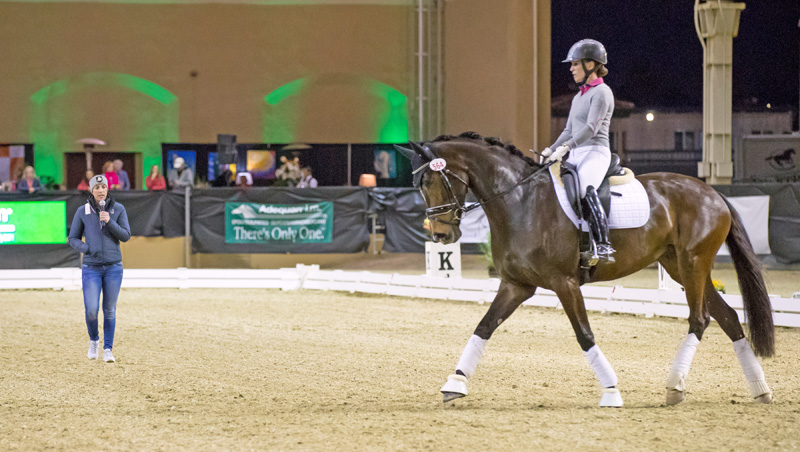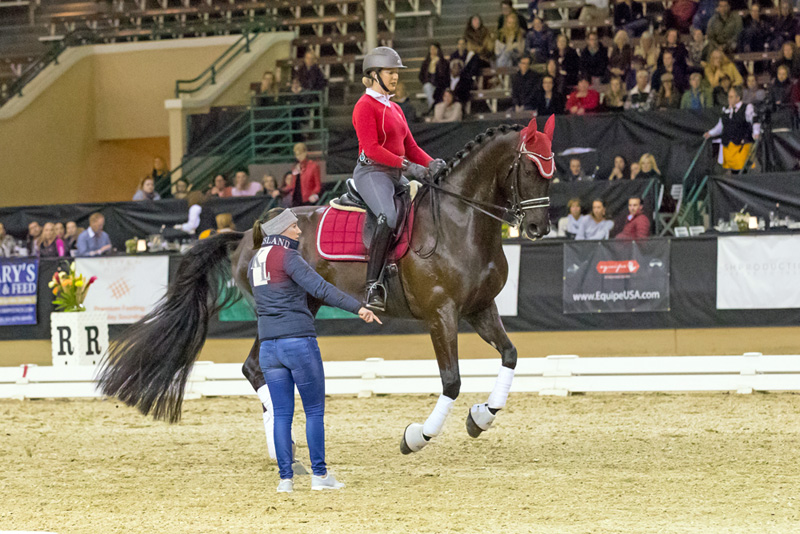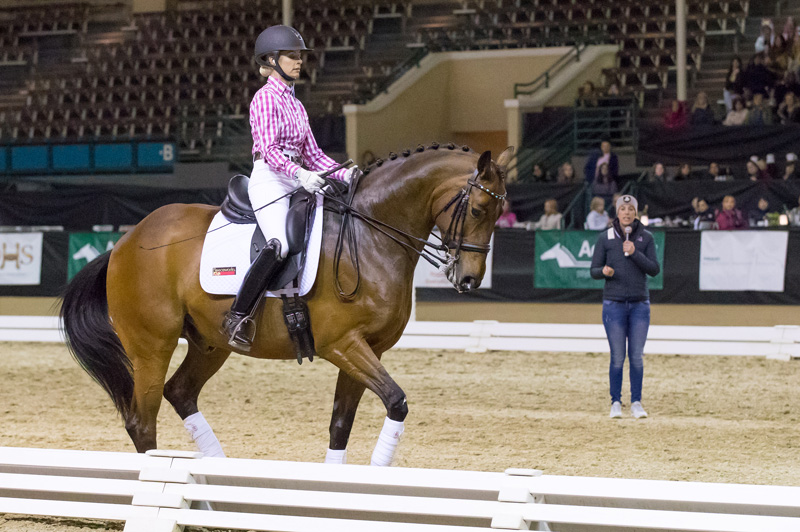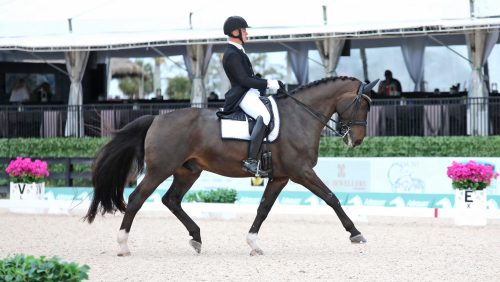California’s inaugural Adequan West Coast Dressage Festival wrapped up its fourth and final leg on a high note with a masterclass by Charlotte Dujardin that was as entertaining as it was educational.
During the Feb. 16 session, which was not live-streamed, Britain’s three-time Olympic gold medalist touched on everything from the importance of riding correct transitions every time to the nature of major competitions. (“There is no getting away from those judges; they are everywhere.”)
Over the course of 90 minutes, Dujardin worked with three combinations and playfully displayed her no-nonsense approach to training. “Why are you stopping like that?” she asked one rider. “We don’t do that.” To another, she said, “Good is a 7. Who wants a 7? Not me. I want 8s and 9s.”

Charlotte Dujardin shared a joke with Lehua Custer, who rode F.J. Ramzes in the masterclass. Photo by Terri Miller
First into the arena was Rebecca Rigdon-Blake and Iquem (Charmeur—Très Bien Sijgje, Moreno). After a few spooky moments, the 5-year-old Dutch Warmblood mare owned by Nancy Blake and Terri Elsesser-Stark adapted to the Del Mar Arena and showed serious potential for the future.
Dujardin may have made her name at the international level, but developing youngsters is her passion. “It’s all about learning about the horse—their strengths and weaknesses and about their character,” she said. “I hope every single horse I ride and train will be a Grand Prix horse.”
Dujardin, who has seven mares in training at the moment, praised Iquem’s rhythm and her natural swing and cadence. “Look how loose and elastic she is,” she noted. Seeing the horse relaxed in such a charged setting is “really exciting,” she added.

Charlotte Dujardin helping Rebecca Rigdon-Blake and Iquem. Photo by Terri Miller
“You want the horse to be happy and enthusiastic. I like horses that want to try and please you all the time,” Dujardin said.
Valegro took “years and years and years” of training to develop suppleness and self-carriage. “He had so much power—his hind legs pushed him so forward that all he did was drive and get strong in my hand… It was my job to make him supple and even in the two reins.”
Iquem, she observed, has three super gaits. But Dujardin cautioned Rigdon-Blake not to get too much impulsion at canter. “At the moment, her canter is so big and so long. She’s got to learn to sit so she pushes her bum down and brings the shoulder up.”
Beginning with walk-trot, trot-walk transitions, Dujardin said young horses must always think “forward” and to go from the rider’s leg. “They have their whole lives to be collected,” she emphasized.
Maintaining a “nice, easy outline” is another goal. “The worst thing you could do is force her to be uphill in an outline that she’s not ready to be in.”
Rising trot allows the horse to swing through the back and become more supple. “And that’s what it’s all about,” Dujardin said. “Dressage is about gymnastics.”
When training young horses, it’s often about doing less. “For a horse with this [kind of] movement, 20 minutes is more than enough,” said Dujardin. “The horses get tired. They want to stretch and be able to loosen up those muscles.” And that presents an opportunity for teaching the horse how to stretch correctly.
When assessing a young horse, Dujardin doesn’t look for youngsters with a “10” walk. “It’s very difficult to collect a horse with a big walk,” she said. Instead, she prefers a correct walk with a good rhythm.
ADVERTISEMENT
Similarly, she considers what the canter might become with proper training: “What’s that going to look like when I collect? What’s it going to look like when I do the flying change? The pirouette?”
The trot, she said, is the gait she worries about the least. “You can train and change the trot by teaching suspension.”
Lehua Custer rode Wendy Sasser’s F.J. Ramzes next. The 8-year-old Dutch Warmblood gelding (Juventus—J Rambiance, Rampal) had won the Prix St. Georges in Del Mar the day before with a score of 72.79 percent, but Dujardin suggested there was still plenty of room for improvement.
“For a big horse, he’s not long—he’s actually quite compact—and a lovely hind leg, a good engine,” she said.
As the pair cantered in a large circle around her, Dujardin asked Custer to focus on getting Ramzes to accept her leg aids. “He’s quite a hot horse,” she said. “You’ve got to make him accept your legs.”

Lehua Custer canters around Charlotte Dujardin on F.J. Ramzes. Photo by Terri Miller
When the rider adjusts the horse’s tempo, the horse mustn’t get stronger in the hand or drop down. “It’s not about how much speed you get, but about how much ground cover you get.”
“I want to see those reactions,” Dujardin added. “What happens when she touches those reins? Next time when you collect him, see if you can keep a bit more energy underneath you. Don’t let him stiffen.”
Dujardin likes using travers to encourage suppleness, and she asked Custer to trot Ramzes down the long side of the arena in haunches-in, playing with the tempo and testing the horse’s reactions.
“The corners are there to help you,” she reminded her. “Watching tests, it’s fascinating how many people forget to actually use those corners and short sides to help them.”
In preparation for the pirouettes, Dujardin asked Custer to canter on a circle—first in haunches-in and then in shoulder-fore—gradually decreasing and then increasing the size of the circle while keeping the activity.
“For a big horse he’s very light and very powerful,” she said. “You don’t hear him stamping his feet.”
From there, Dujardin instructed Custer to ride a canter half-pass from M to X, a slight shoulder-fore, a half 10-meter circle in travers, and then turn and go back in half-pass. The rider should think of the front end riding a 10-meter circle, while the haunches are on an 8-meter circle.
“The worst thing you can do is ride test pirouettes all the time because the horse anticipates,” she explained. “[Ramzes] has a huge ability to sit, but at the moment he almost over-sits and collects too much, and she’s not able to ride with that forward feeling.”
Riders must learn for themselves whether a movement is right or wrong, she added. “Dressage is all about repeating exercises until you get it right, and being disciplined as a rider and not being sloppy. If you ride bad transitions at home, you get bad transitions in the arena.”
ADVERTISEMENT
After asking Custer to demonstrate the horse’s naturally correct trot, Dujardin asked her to sit and add suspension, followed by a few steps of passage. “Look how the whole picture changes,” she said. “You can see how talented he’s going to be for the Grand Prix work.”
Niki Clarke and Jennifer Mason’s 10-year-old Oldenburg gelding Quincy (Quaterback—Breanna, Brentano II) were the last combination. Clarke has been training the horse since he was 5, and they made their Grand Prix debut in January.
Dujardin called Clarke “a very elegant, very quiet rider. She’s very soft and very effective in the way that she rides,” she said. “What I love is she has the ability to adapt to lots of different horses.”
Riders, she noted, can’t expect the same thing from different horses. “You have to work out what their strengths and their weaknesses are,” she said. “Can you put a bit more pressure on them? Some you can; some you can’t. Some are clever; some aren’t so clever. Some you can teach something, and the next day they’ve got it. With other horses you’re teaching the same thing for a few months. It depends on the horse and how the horse learns.”
Dujardin started with an exercise to improve the zigzag—riding six strides of leg yield away from the rail and six strides of leg yield back. “Leg yield isn’t a movement in a test,” she said, “but it’s an exercise I use because it makes the horse move away from your leg.”
She had Clarke count her strides—“over, two, three, four, straight, change”—while remembering to keep the horse parallel, positioned for the new direction, and uphill.
Dujardin asked Clarke to ride the zigzags more steeply, increasing the angle of the leg yield, and then ride the exercise from the center line, until they finally rode the movement using half-pass instead of leg yield.
“There’s so much to think about,” Dujardin added, ticking off the expectations of the judges: equal bend and distance covered on each side, the horse uphill and in self-carriage, and a clean flying change. “And you’ve got to count. And it’s got a co-efficient of times two. It’s a very important movement.”
Dujardin also had the pair ride an exercise designed to keep the horse from anticipating piaffe from passage. As Clarke trotted Quincy in a large circle, she increased and decreased the tempo and alternated between regular trot, working trot, and passage. “You can play with the tempo in the passage,” she said. “He’s got to be able to go forward and back without taking over.”

Niki Clarke worked on piaffe-passage-trot on Quincy as Charlotte Dujardin looked on. Photo by Terri Miller
“You’ve got so many trots,” Dujardin explained. “Why get stuck with one or two? You’ve got to play with it and keep the horse interested and motivated. If you ride the horse in one outline, in one rhythm, the whole time, the horse becomes stiff and lazy.”
The Masterclass offered insight into what drives Dujardin to succeed. “I love being told that something isn’t good enough and how I can improve it to make it better.”
COTH has covered Masterclasses and clinics from Dujardin, Monty Roberts and Boyd Martin, Helen Langehanenberg, Laura Graves, Richard Spooner, Anne Kursinksi, Carl Hester and more recently. Check them all out in our Clinic Reports section.














